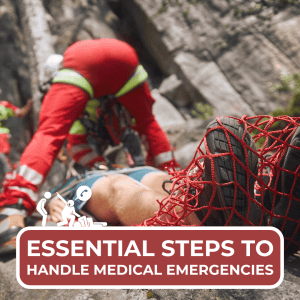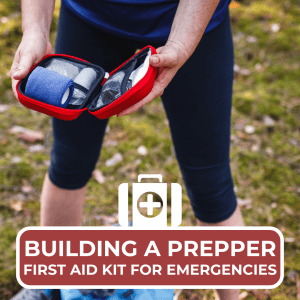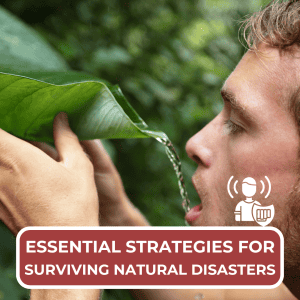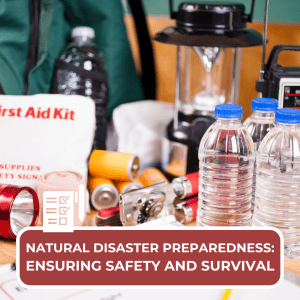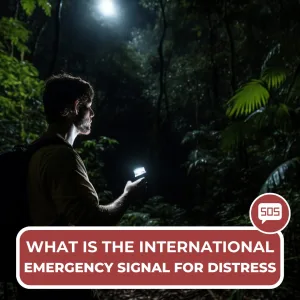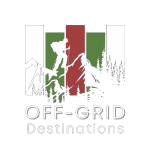
Surviving a major emergency means having a plan before you need one. Whether facing unexpected disasters or finding yourself off-grid, a well-thought-out strategy is your most critical tool.
This guide will walk you through creating a personal survival plan tailored to your exact needs. You will learn how to prepare for reality, embrace self-sufficiency, and become the ultimate survivor.
Table of Contents
ToggleKey Takeaways
- A personal survival plan requires a thorough assessment of your group’s size, potential emergencies specific to your location, and your level of outdoor experience.
- Official sources like FEMA’s Ready.gov recommend being prepared to be self-sufficient for a minimum of 72 hours, though preparing for up to two weeks is becoming the new standard.
- Your survival kit must include essential supplies for shelter, fire, clean water, and first aid. Named products like the Sawyer Squeeze water filter or Adventure Medical Kits offer reliable options.
- Customizing your kit is crucial. You must account for personal medical conditions, include self-defense tools that comply with local laws, and pack communication devices like a NOAA weather radio.
What Is Off-the-Grid Survival?

Off-the-grid survival is the practice of being self-reliant without public utilities. This means you can provide your own food, clean water, and power when services are down.
Survivalists focus on practical skills to thrive in any situation. They learn to use natural resources and make their own tools.
A core concept is the “Rule of 3s,” which prioritizes your actions. Humans can generally survive 3 minutes without air, 3 hours without shelter in extreme conditions, 3 days without water, and 3 weeks without food.
Living off-grid also involves finding alternative power sources. Many people use solar panels from companies like Goal Zero or portable power stations from Jackery to keep essential devices running.
This lifestyle gives you freedom and security during events like natural disasters. It demands careful planning but ensures you are prepared for any condition.
How Do You Start Developing a Personal Survival Plan?

The first step is a realistic assessment of your situation. You need to consider who you are planning for, the specific threats you face, your environment, your skills, and how long you might be on your own.
Assess the number of people in your plan
Knowing who you are responsible for is the foundation of your plan. The number of people directly impacts the amount of food, water, and supplies you need.
A plan for one person is simple, but a family of five requires much more. You must also consider the specific needs of each person. Do you have infants who need formula and diapers, or elderly members with mobility challenges or specific medications?
Don’t forget pets. Ensure you have a plan that includes their food, water, and any necessary medications.
Identify potential emergencies
You can’t prepare for everything, but you can prepare for the most likely threats in your area. This is a key part of surviving natural disasters.
Consult resources like FEMA’s Ready.gov to understand regional risks. For example, if you live on the West Coast, your plan should prioritize earthquake preparedness, while those in the Midwest should focus on tornadoes.
Consider other possibilities like extended power outages, severe winter storms, or wildfires. Your plan should address the top 2-3 most probable emergencies for your specific location.
Determine the location of use
Where you plan to ride out an emergency drastically changes your needs. A survival plan for a dense urban environment looks very different from one for a remote, rural area.
Urban survival might require tools to shut off utilities or navigate blocked streets. Rural survival often focuses more on creating shelter, sourcing water, and dealing with wildlife.
Your gear and strategy must match your environment. High-altitude locations require gear for cold and sickness, while coastal areas demand a plan for flooding or hurricanes.
Assess your outdoor experience level
Be honest about your skills. Your experience level determines what gear you can effectively use and what challenges you can realistically handle.
If you are new to the outdoors, focus on basic, reliable tools and fundamental skills. A seasoned hiker may be comfortable with more advanced navigation and shelter-building techniques.
To improve your readiness, consider taking a Wilderness First Aid course from an organization like NOLS (National Outdoor Leadership School). You can also join a local CERT (Community Emergency Response Team) program to learn practical disaster response skills.
Estimate the waiting period for help
In a widespread disaster, you must assume that help is not coming quickly. Emergency services will be overwhelmed and focused on the most critical incidents.
The standard recommendation has long been to have enough supplies for 72 hours. However, agencies like FEMA now suggest that being prepared for up to two weeks is a safer goal, reflecting the reality of modern disasters.
Your plan should ensure you have enough food, water, and critical supplies to be self-sufficient for your estimated waiting period.
What Are the Essential Supplies for a Survival Kit?

A well-stocked survival kit, often called a “bug-out bag,” should contain everything you need to survive for at least 72 hours. Your kit should be built around the core pillars of survival.
Tools
The right tools are essential for repairs, building shelter, and preparing food. Your kit should include a high-quality multi-tool, like a Leatherman Wave+ or a Victorinox SwissTool.
A sturdy, fixed-blade knife like a Morakniv Companion is also invaluable. Also, pack at least 50-100 feet of paracord and a roll of duct tape, as their uses are nearly limitless.
Illumination
Reliable light is a major safety and morale booster. A hands-free headlamp from a trusted brand like Petzl or Black Diamond is a top priority.
You should also pack a durable, waterproof tactical flashlight from a brand like Fenix or Olight. Always include at least one full set of extra batteries for each device.
Clean water
You cannot survive long without clean water. The CDC recommends storing at least one gallon of water per person per day.
For situations on the move, a portable water filter is non-negotiable. Highly-rated options include the Sawyer Squeeze and the LifeStraw Personal Water Filter, which can remove bacteria and protozoa from water sources.
Also include water purification tablets as a lightweight backup method.
Fire-Starting Kit
Fire provides warmth, a way to cook food and boil water, and a psychological boost. Your kit should have multiple ways to start a fire.
Include a ferrocerium rod (or “ferro rod”) and a striker, as they work even when wet. Also, pack waterproof matches, such as UCO Stormproof Matches, and a reliable lighter in a waterproof case.
Don’t forget tinder. You can pack commercial options like WetFire or make your own by soaking cotton balls in petroleum jelly.
Basic First Aid / Medical Kit
Building a first aid kit is a critical skill for any prepper. You can buy a pre-made kit from a company like Adventure Medical Kits or MyMedic and then customize it.
Your kit must include bandages of various sizes, gauze pads, medical tape, antiseptic wipes, and antibiotic ointment. Also include pain relievers, blister treatment like Moleskin, and any personal prescription medications.
A good first aid manual or guide is also a wise addition. It will help you treat injuries properly in a stressful situation.
How Can You Customize Your Survival Kit?

A generic kit is a good start, but a truly effective plan requires customization. You must tailor your gear to your personal situation, health, and local laws.
Medical Conditions
You must account for any medical conditions in your group. Pack at least a two-week supply of all necessary prescription medications.
Include a written, waterproof list of medications, dosages, and any allergies. If someone requires specific items like an EpiPen, insulin, or an inhaler, make sure you have backups packed and easily accessible.
Self-Defense
Personal safety is a valid concern in a chaotic situation. Your self-defense choices must be legal and ones you are trained to use.
Before packing any tools for self-defense, thoroughly research and understand your local and state laws. Items like pepper spray or a tactical pen can be viable, non-lethal options where permitted.
Your primary goal should always be to avoid confrontations by practicing situational awareness.
Cash or Currency
During a power outage, electronic payment systems will fail. ATMs and credit card readers will be useless.
Including cash in your kit is a smart move. Focus on small bills, as others may not be able to make change. This can be used to purchase essential supplies if stores are still operating on a cash basis.
Communication Devices
Staying informed and being able to call for help is crucial. Since cell networks may be down, you need backup communication options.
A hand-crank or battery-powered NOAA weather radio is essential for receiving emergency broadcasts. For two-way communication in remote areas, consider a satellite messenger like a Garmin inReach or ZOLEO device, which allow you to send texts and SOS signals via satellite.
How Should You Store Your Survival Gear?
Your gear is useless if it’s disorganized or gets damaged. Choosing the right storage system keeps your supplies protected and ready to go at a moment’s notice.
Backpack
A backpack is the most common choice for a “bug-out bag” because it allows for mobility. Choose a durable pack from a reputable brand like Osprey, 5.11 Tactical, or Maxpedition.
Ensure the backpack is large enough to hold all your gear but not so heavy that you can’t carry it for an extended period. A well-fitted pack with a hip belt will make carrying the load much more comfortable.
Soft-Sided Carrying Case
A soft-sided case, like a duffel bag, can be a good option for a vehicle kit or home storage. It offers flexibility for packing oddly shaped items.
Look for cases made from heavy-duty, water-resistant materials. They are great for organizing specific categories of gear, like a dedicated medical kit or a vehicle recovery kit.
Rigid Carrying Case
For sensitive or fragile items, a rigid carrying case offers the best protection. Companies like Pelican are the industry standard for waterproof, dustproof, and crushproof cases.
These are ideal for storing delicate electronics, communication devices, or a comprehensive medical kit. Their durability ensures your most critical gear will survive even the roughest conditions.
Float Bag
If you live in a flood-prone area or your evacuation plan involves crossing water, a float bag is essential. Also known as a dry bag, it will keep your gear completely dry.
Brands like Sea to Summit offer reliable dry bags in various sizes. You can use a large one to line your entire backpack or smaller ones to protect specific items like electronics and clothing.
Conclusion and Frequently Asked Questions
Creating a personal survival plan is the most important step you can take for your safety. By assessing your unique situation, identifying likely emergencies, and building a customized kit, you are prepared to face any challenge.
Remember that a plan is a living document. You should review and update it at least once a year to ensure your supplies are fresh and your strategy is still relevant.
Stay prepared, and you will stay safe.
What is an off-grid survival plan?
An off-grid survival plan is a personal strategy to ensure your safety and well-being in emergency situations when you are disconnected from essential utilities like electricity, water, or communications. It includes having the necessary supplies, skills, and knowledge to be self-sufficient.
How do I create an off-grid survival plan?
To create an off-grid survival plan, assess potential risks specific to your area, determine how many people you are planning for, and gather essential supplies. Your plan should cover shelter, water, food, fire, first aid, and communication.
Why is it important to have an off-grid survival plan?
Having an off-grid survival plan prepares you for unexpected emergencies, like natural disasters or extended power outages, where normal services are unavailable. It increases your chances of staying safe, healthy, and comfortable during challenging times.
What should be included in an off-grid survival kit?
An essential off-grid survival kit should include a water filter (like a Sawyer Squeeze), multiple fire starters, a first-aid kit, a multi-tool or knife, a headlamp, emergency shelter like a tarp or SOL Bivvy, navigation tools, and non-perishable food.

